Deck 4: Logical Database Design and the Relational Model
Question
Question
Question
Question
Question
Question
Question
Question
Question
Question
Question
Question
Question
Question
Question
Question
Question
Question
Question
Question
Question
Question
Question
Question
Question
Question
Question
Question
Question
Question
Question
Question
Question
Question
Question
Question
Question
Question
Question
Question
Question
Question
Question
Question
Question
Question
Question
Question
Question
Question
Question
Question
Question
Question
Question
Question
Question
Question
Question
Question
Question
Question
Question
Question
Question
Question
Question
Question
Question
Question
Question
Question
Question
Question
Question
Question
Question
Question
Question
Question

Unlock Deck
Sign up to unlock the cards in this deck!
Unlock Deck
Unlock Deck
1/101
Play
Full screen (f)
Deck 4: Logical Database Design and the Relational Model
1
Data is represented in the form of:
A) data trees.
B) tables.
C) data notes.
D) chairs.
A) data trees.
B) tables.
C) data notes.
D) chairs.
B
2
A domain definition consists of all of the following components EXCEPT:
A) domain name.
B) data type.
C) integrity constraints.
D) size.
A) domain name.
B) data type.
C) integrity constraints.
D) size.
C
3
In the figure below, Customer_ID in the CUSTOMER Table is which type of key? 
A) Composite
B) Candidate
C) Standard
D) Grouped

A) Composite
B) Candidate
C) Standard
D) Grouped
B
4
An attribute (or attributes) that uniquely identifies each row in a relation is called a:
A) column.
B) foreign field.
C) primary key.
D) duplicate key.
A) column.
B) foreign field.
C) primary key.
D) duplicate key.

Unlock Deck
Unlock for access to all 101 flashcards in this deck.
Unlock Deck
k this deck
5
An attribute in a relation of a database that serves as the primary key of another relation in the same database is called a:
A) link attribute.
B) link key.
C) foreign key.
D) foreign attribute.
A) link attribute.
B) link key.
C) foreign key.
D) foreign attribute.

Unlock Deck
Unlock for access to all 101 flashcards in this deck.
Unlock Deck
k this deck
6
A two-dimensional table of data sometimes is called a:
A) group.
B) set.
C) declaration.
D) relation.
A) group.
B) set.
C) declaration.
D) relation.

Unlock Deck
Unlock for access to all 101 flashcards in this deck.
Unlock Deck
k this deck
7
Which of the following is NOT a reason to create an instance of a relational schema with sample data?
A) Sample data can be used to improve user communications.
B) Sample data can be used for prototype generation.
C) Sample data can reverse database implementation errors.
D) Sample data provide a convenient way to check the accuracy of your design.
A) Sample data can be used to improve user communications.
B) Sample data can be used for prototype generation.
C) Sample data can reverse database implementation errors.
D) Sample data provide a convenient way to check the accuracy of your design.

Unlock Deck
Unlock for access to all 101 flashcards in this deck.
Unlock Deck
k this deck
8
________ is a component of the relational data model included to specify business rules to maintain the integrity of data when they are manipulated.
A) Business rule constraint
B) Data integrity
C) Business integrity
D) Data structure
A) Business rule constraint
B) Data integrity
C) Business integrity
D) Data structure

Unlock Deck
Unlock for access to all 101 flashcards in this deck.
Unlock Deck
k this deck
9
A primary key that consists of more than one attribute is called a:
A) foreign key.
B) composite key.
C) multivalued key.
D) cardinal key.
A) foreign key.
B) composite key.
C) multivalued key.
D) cardinal key.

Unlock Deck
Unlock for access to all 101 flashcards in this deck.
Unlock Deck
k this deck
10
A primary key whose value is unique across all relations is called a(n):
A) global primary key.
B) inter-table primary key.
C) enterprise key.
D) foreign global key.
A) global primary key.
B) inter-table primary key.
C) enterprise key.
D) foreign global key.

Unlock Deck
Unlock for access to all 101 flashcards in this deck.
Unlock Deck
k this deck
11
The normal form which removes any remaining functional dependencies because there was more than one primary key for the same nonkeys is called:
A) fifth normal form.
B) fourth normal form.
C) Boyce-Codd normal form.
D) sixth normal form.
A) fifth normal form.
B) fourth normal form.
C) Boyce-Codd normal form.
D) sixth normal form.

Unlock Deck
Unlock for access to all 101 flashcards in this deck.
Unlock Deck
k this deck
12
The entity integrity rule states that:
A) no primary key attribute can be null.
B) referential integrity must be maintained across all entities.
C) each entity must have a primary key.
D) a primary key must have only one attribute.
A) no primary key attribute can be null.
B) referential integrity must be maintained across all entities.
C) each entity must have a primary key.
D) a primary key must have only one attribute.

Unlock Deck
Unlock for access to all 101 flashcards in this deck.
Unlock Deck
k this deck
13
The ________ states that no primary key attribute may be null.
A) referential integrity constraint
B) entity integrity rule
C) partial specialization rule
D) range domain rule
A) referential integrity constraint
B) entity integrity rule
C) partial specialization rule
D) range domain rule

Unlock Deck
Unlock for access to all 101 flashcards in this deck.
Unlock Deck
k this deck
14
In the SQL language, the ________ statement is used to make table definitions.
A) create session
B) create table
C) create index
D) select
A) create session
B) create table
C) create index
D) select

Unlock Deck
Unlock for access to all 101 flashcards in this deck.
Unlock Deck
k this deck
15
Which of the following are properties of relations?
A) Each attribute has the same name.
B) No two rows in a relation are identical.
C) There are multivalued attributes in a relation.
D) All columns are numeric.
A) Each attribute has the same name.
B) No two rows in a relation are identical.
C) There are multivalued attributes in a relation.
D) All columns are numeric.

Unlock Deck
Unlock for access to all 101 flashcards in this deck.
Unlock Deck
k this deck
16
All of the following are the main goals of normalization EXCEPT:
A) minimize data redundancy.
B) simplify the enforcement of referential integrity.
C) maximize storage space.
D) make it easier to maintain data.
A) minimize data redundancy.
B) simplify the enforcement of referential integrity.
C) maximize storage space.
D) make it easier to maintain data.

Unlock Deck
Unlock for access to all 101 flashcards in this deck.
Unlock Deck
k this deck
17
A form of database design which maps conceptual requirements is called:
A) logical designs.
B) response designs.
C) security design.
D) physical design.
A) logical designs.
B) response designs.
C) security design.
D) physical design.

Unlock Deck
Unlock for access to all 101 flashcards in this deck.
Unlock Deck
k this deck
18
Which of the following violates the atomic property of relations?
A) Sam
B) Hinz
C) Sam Hinz
D) Atomic
A) Sam
B) Hinz
C) Sam Hinz
D) Atomic

Unlock Deck
Unlock for access to all 101 flashcards in this deck.
Unlock Deck
k this deck
19
When all multivalued attributes have been removed from a relation, it is said to be in:
A) first normal form.
B) second normal form.
C) Boyce-Codd normal form.
D) third normal form.
A) first normal form.
B) second normal form.
C) Boyce-Codd normal form.
D) third normal form.

Unlock Deck
Unlock for access to all 101 flashcards in this deck.
Unlock Deck
k this deck
20
In the figure below, the primary key for "Order Line" is which type of key? 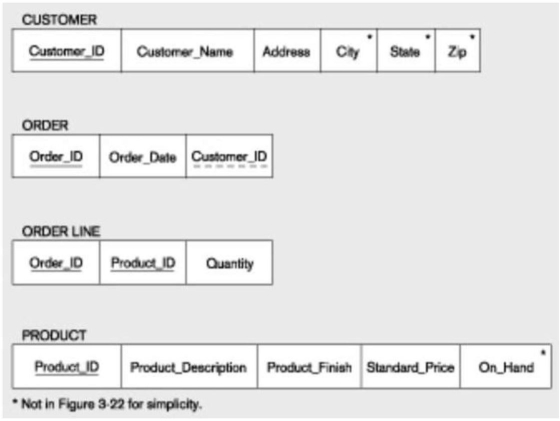
A) Composite
B) Foreign
C) Standard
D) Grouped

A) Composite
B) Foreign
C) Standard
D) Grouped

Unlock Deck
Unlock for access to all 101 flashcards in this deck.
Unlock Deck
k this deck
21
________ problems are encountered when removing data with transitive dependencies.
A) Insertion
B) Modification
C) Deletion
D) Merging
A) Insertion
B) Modification
C) Deletion
D) Merging

Unlock Deck
Unlock for access to all 101 flashcards in this deck.
Unlock Deck
k this deck
22
A functional dependency in which one or more nonkey attributes are functionally dependent on part, but not all, of the primary key is called a ________ dependency.
A) partial key-based
B) partial functional
C) cross key
D) merged relation
A) partial key-based
B) partial functional
C) cross key
D) merged relation

Unlock Deck
Unlock for access to all 101 flashcards in this deck.
Unlock Deck
k this deck
23
In the figure below, what type of relationship do the relations depict? 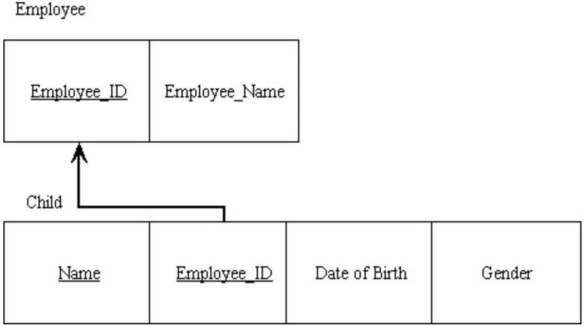
A) Identifying entity/weak entity
B) Multivalued
C) Composite foreign key
D) One-to-many

A) Identifying entity/weak entity
B) Multivalued
C) Composite foreign key
D) One-to-many

Unlock Deck
Unlock for access to all 101 flashcards in this deck.
Unlock Deck
k this deck
24
The attribute on the left-hand side of the arrow in a functional dependency is the:
A) candidate key.
B) determinant.
C) foreign key.
D) primary key.
A) candidate key.
B) determinant.
C) foreign key.
D) primary key.

Unlock Deck
Unlock for access to all 101 flashcards in this deck.
Unlock Deck
k this deck
25
A constraint between two attributes is called a(n):
A) functional relation.
B) attribute dependency.
C) functional dependency.
D) functional relation constraint.
A) functional relation.
B) attribute dependency.
C) functional dependency.
D) functional relation constraint.

Unlock Deck
Unlock for access to all 101 flashcards in this deck.
Unlock Deck
k this deck
26
A nonkey attribute is also called a(n):
A) column.
B) unimportant datum.
C) descriptor.
D) address.
A) column.
B) unimportant datum.
C) descriptor.
D) address.

Unlock Deck
Unlock for access to all 101 flashcards in this deck.
Unlock Deck
k this deck
27
An attribute that may have more than one meaning is called a(n):
A) homonym.
B) alias.
C) double defined attribute.
D) synonym.
A) homonym.
B) alias.
C) double defined attribute.
D) synonym.

Unlock Deck
Unlock for access to all 101 flashcards in this deck.
Unlock Deck
k this deck
28
A candidate key must satisfy all of the following conditions EXCEPT:
A) the key must uniquely identify the row.
B) the key must indicate the row's position in the table.
C) the key must be nonredundant.
D) each nonkey attribute is functionally dependent upon it.
A) the key must uniquely identify the row.
B) the key must indicate the row's position in the table.
C) the key must be nonredundant.
D) each nonkey attribute is functionally dependent upon it.

Unlock Deck
Unlock for access to all 101 flashcards in this deck.
Unlock Deck
k this deck
29
In the figure below, what is depicted? 
A) A one-to-one relationship
B) A unary relationship
C) A one-to-many relationship
D) An associative entity

A) A one-to-one relationship
B) A unary relationship
C) A one-to-many relationship
D) An associative entity

Unlock Deck
Unlock for access to all 101 flashcards in this deck.
Unlock Deck
k this deck
30
When a regular entity type contains a multivalued attribute, one must:
A) create a single relation with multiple lines for each instance of the multivalued attribute.
B) create two new relations, one containing the multivalued attribute.
C) create two new relations, both containing the multivalued attribute.
D) delete the relation and start over.
A) create a single relation with multiple lines for each instance of the multivalued attribute.
B) create two new relations, one containing the multivalued attribute.
C) create two new relations, both containing the multivalued attribute.
D) delete the relation and start over.

Unlock Deck
Unlock for access to all 101 flashcards in this deck.
Unlock Deck
k this deck
31
Two or more attributes having different names but the same meaning are called:
A) homonyms.
B) aliases.
C) synonyms.
D) alternate attributes.
A) homonyms.
B) aliases.
C) synonyms.
D) alternate attributes.

Unlock Deck
Unlock for access to all 101 flashcards in this deck.
Unlock Deck
k this deck
32
The need to ________ relations commonly occurs when different views need to be integrated.
A) metadata
B) system
C) drop
D) merge
A) metadata
B) system
C) drop
D) merge

Unlock Deck
Unlock for access to all 101 flashcards in this deck.
Unlock Deck
k this deck
33
In the figure below, what type of key is depicted? 
A) Primary
B) Recursive primary
C) Composite
D) Recursive foreign

A) Primary
B) Recursive primary
C) Composite
D) Recursive foreign

Unlock Deck
Unlock for access to all 101 flashcards in this deck.
Unlock Deck
k this deck
34
In the figure below, what type of relationship do the relations depict? 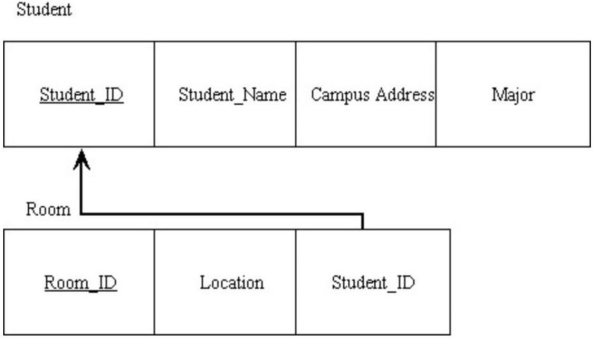
A) Identifying entity/weak entity
B) One-to-many
C) Ternary
D) Many-to-many

A) Identifying entity/weak entity
B) One-to-many
C) Ternary
D) Many-to-many

Unlock Deck
Unlock for access to all 101 flashcards in this deck.
Unlock Deck
k this deck
35
A relation that contains no multivalued attributes and has nonkey attributes solely dependent on the primary key but contains transitive dependencies is in which normal form?
A) First
B) Second
C) Third
D) Fourth
A) First
B) Second
C) Third
D) Fourth

Unlock Deck
Unlock for access to all 101 flashcards in this deck.
Unlock Deck
k this deck
36
Referring to the figure below, which of the following is NOT true? 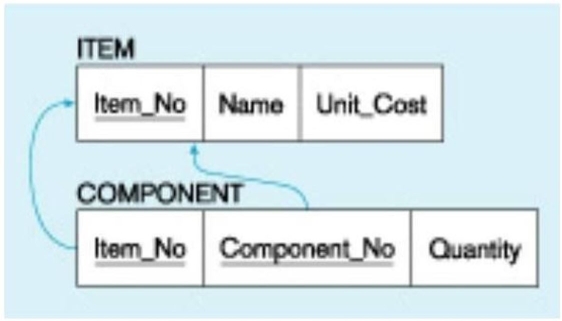
A) A component is part of an item.
B) A component is always used in only one item.
C) A component can be part of an item.
D) A component may be used in many items.

A) A component is part of an item.
B) A component is always used in only one item.
C) A component can be part of an item.
D) A component may be used in many items.

Unlock Deck
Unlock for access to all 101 flashcards in this deck.
Unlock Deck
k this deck
37
An alternative name for an attribute is called a(n):
A) synonym.
B) alias.
C) alternate attribute.
D) related characteristic.
A) synonym.
B) alias.
C) alternate attribute.
D) related characteristic.

Unlock Deck
Unlock for access to all 101 flashcards in this deck.
Unlock Deck
k this deck
38
A functional dependency between two or more nonkey attributes is called a:
A) partial functional dependency.
B) partial nonkey dependency.
C) transitive dependency.
D) partial transitive dependency.
A) partial functional dependency.
B) partial nonkey dependency.
C) transitive dependency.
D) partial transitive dependency.

Unlock Deck
Unlock for access to all 101 flashcards in this deck.
Unlock Deck
k this deck
39
The normal form which deals with multivalued dependencies is called:
A) fifth normal form.
B) fourth normal form.
C) Boyce-Codd normal form.
D) sixth normal form.
A) fifth normal form.
B) fourth normal form.
C) Boyce-Codd normal form.
D) sixth normal form.

Unlock Deck
Unlock for access to all 101 flashcards in this deck.
Unlock Deck
k this deck
40
Understanding the steps involved in transforming EER diagrams into relations is important because:
A) one must be able to check the output of a CASE tool.
B) there are rarely legitimate alternatives from which to choose.
C) CASE tools can model any situation.
D) CASE tools model hypothetical business problems.
A) one must be able to check the output of a CASE tool.
B) there are rarely legitimate alternatives from which to choose.
C) CASE tools can model any situation.
D) CASE tools model hypothetical business problems.

Unlock Deck
Unlock for access to all 101 flashcards in this deck.
Unlock Deck
k this deck
41
A foreign key is a primary key of a relation that also is a primary key in another relation.

Unlock Deck
Unlock for access to all 101 flashcards in this deck.
Unlock Deck
k this deck
42
The columns of a relation can be interchanged without changing the meaning or use of the relation.

Unlock Deck
Unlock for access to all 101 flashcards in this deck.
Unlock Deck
k this deck
43
A primary key is an attribute that uniquely identifies each row in a relation.

Unlock Deck
Unlock for access to all 101 flashcards in this deck.
Unlock Deck
k this deck
44
One property of a relation is that each attribute within a relation has a unique name.

Unlock Deck
Unlock for access to all 101 flashcards in this deck.
Unlock Deck
k this deck
45
When a regular entity type contains a multivalued attribute, two new relations are created.

Unlock Deck
Unlock for access to all 101 flashcards in this deck.
Unlock Deck
k this deck
46
There can be multivalued attributes in a relation.

Unlock Deck
Unlock for access to all 101 flashcards in this deck.
Unlock Deck
k this deck
47
Unlike columns, the rows of a relation may not be interchanged and must be stored in one sequence.

Unlock Deck
Unlock for access to all 101 flashcards in this deck.
Unlock Deck
k this deck
48
A rule that states that each foreign key value must match a primary key value in the other relation is called the:
A) referential integrity constraint.
B) key match rule.
C) entity key group rule.
D) foreign/primary match rule.
A) referential integrity constraint.
B) key match rule.
C) entity key group rule.
D) foreign/primary match rule.

Unlock Deck
Unlock for access to all 101 flashcards in this deck.
Unlock Deck
k this deck
49
CASE tools can model more complex data relationships, such as ternary relationships.

Unlock Deck
Unlock for access to all 101 flashcards in this deck.
Unlock Deck
k this deck
50
When two or more attributes describe the same characteristic of an entity, they are synonyms.

Unlock Deck
Unlock for access to all 101 flashcards in this deck.
Unlock Deck
k this deck
51
________ anomalies can be caused by editing data in tables.
A) Insertion
B) Deletion
C) Modification
D) Creation
A) Insertion
B) Deletion
C) Modification
D) Creation

Unlock Deck
Unlock for access to all 101 flashcards in this deck.
Unlock Deck
k this deck
52
View integration is the process of merging relations together.

Unlock Deck
Unlock for access to all 101 flashcards in this deck.
Unlock Deck
k this deck
53
A relation that contains minimal redundancy and allows easy use is considered to be:
A) clean.
B) simple.
C) complex.
D) well-structured.
A) clean.
B) simple.
C) complex.
D) well-structured.

Unlock Deck
Unlock for access to all 101 flashcards in this deck.
Unlock Deck
k this deck
54
A composite key consists of only one attribute.

Unlock Deck
Unlock for access to all 101 flashcards in this deck.
Unlock Deck
k this deck
55
A synonym is an attribute that may have more than one meaning.

Unlock Deck
Unlock for access to all 101 flashcards in this deck.
Unlock Deck
k this deck
56
All values that appear in a column of a relation must be taken from the same domain.

Unlock Deck
Unlock for access to all 101 flashcards in this deck.
Unlock Deck
k this deck
57
Data structures include data organized in the form of tables with rows and columns.

Unlock Deck
Unlock for access to all 101 flashcards in this deck.
Unlock Deck
k this deck
58
An enterprise key is a foreign key whose value is unique across all relations.

Unlock Deck
Unlock for access to all 101 flashcards in this deck.
Unlock Deck
k this deck
59
The figure below is an example of mapping which type of relationship? 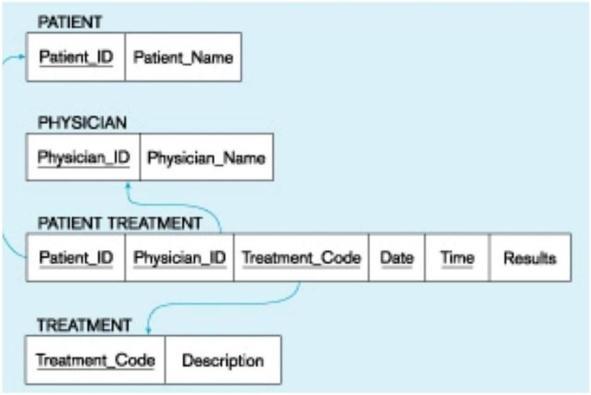
A) First
B) Second
C) Unary
D) Ternary

A) First
B) Second
C) Unary
D) Ternary

Unlock Deck
Unlock for access to all 101 flashcards in this deck.
Unlock Deck
k this deck
60
Sample data are useful for developing prototype applications and for testing queries.

Unlock Deck
Unlock for access to all 101 flashcards in this deck.
Unlock Deck
k this deck
61
When transforming a one-to-one relationship, a new relation is always created.

Unlock Deck
Unlock for access to all 101 flashcards in this deck.
Unlock Deck
k this deck
62
The entity integrity rule states that a primary key attribute can be null.

Unlock Deck
Unlock for access to all 101 flashcards in this deck.
Unlock Deck
k this deck
63
In the figure below, each employee has exactly one manager. 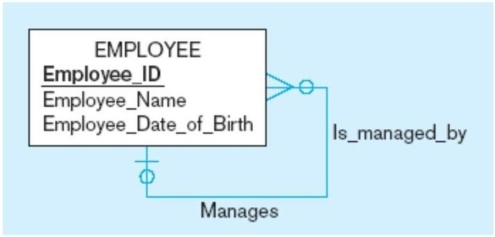


Unlock Deck
Unlock for access to all 101 flashcards in this deck.
Unlock Deck
k this deck
64
An identifier assigned to an associative entity is also called a cross-relation key.

Unlock Deck
Unlock for access to all 101 flashcards in this deck.
Unlock Deck
k this deck
65
In the relational data model, associations between tables are defined through the use of primary keys.

Unlock Deck
Unlock for access to all 101 flashcards in this deck.
Unlock Deck
k this deck
66
A cascading delete removes all records in other tables associated with the record to be deleted.

Unlock Deck
Unlock for access to all 101 flashcards in this deck.
Unlock Deck
k this deck
67
The truncate table statement in SQL creates a new table.

Unlock Deck
Unlock for access to all 101 flashcards in this deck.
Unlock Deck
k this deck
68
A co-dependency is a constraint between two attributes or two sets of attributes.

Unlock Deck
Unlock for access to all 101 flashcards in this deck.
Unlock Deck
k this deck
69
When transforming a weak entity, one should create one relation with both the attributes of the strong entity and the attributes of the weak entity.

Unlock Deck
Unlock for access to all 101 flashcards in this deck.
Unlock Deck
k this deck
70
A well-structured relation contains minimal redundancy and allows users to manipulate the relation without errors or inconsistencies.

Unlock Deck
Unlock for access to all 101 flashcards in this deck.
Unlock Deck
k this deck
71
Data integrity consists of powerful operations to manipulate data stored in relations.

Unlock Deck
Unlock for access to all 101 flashcards in this deck.
Unlock Deck
k this deck
72
A relation in fifth normal form may not contain any anomalies.

Unlock Deck
Unlock for access to all 101 flashcards in this deck.
Unlock Deck
k this deck
73
An anomaly is a type of flaw in the database server.

Unlock Deck
Unlock for access to all 101 flashcards in this deck.
Unlock Deck
k this deck
74
The primary key of the many side migrates to the one side when transforming a one-to-many relationship.

Unlock Deck
Unlock for access to all 101 flashcards in this deck.
Unlock Deck
k this deck
75
When transforming a unary many-to-many relationship to relations, a recursive foreign key is used.

Unlock Deck
Unlock for access to all 101 flashcards in this deck.
Unlock Deck
k this deck
76
A referential integrity constraint is a rule that maintains consistency among the rows of two relations.

Unlock Deck
Unlock for access to all 101 flashcards in this deck.
Unlock Deck
k this deck
77
If an identifier is not assigned, the default primary key for an associative relation consists of the two primary key attributes from the other two relations.

Unlock Deck
Unlock for access to all 101 flashcards in this deck.
Unlock Deck
k this deck
78
The allowable range of values for a given attribute is part of the domain constraint.

Unlock Deck
Unlock for access to all 101 flashcards in this deck.
Unlock Deck
k this deck
79
The relational data model does, at this time, directly support subtype/supertype relationships.

Unlock Deck
Unlock for access to all 101 flashcards in this deck.
Unlock Deck
k this deck
80
When normalizing, the goal is to decompose relations with anomalies to produce smaller, well-structured relations.

Unlock Deck
Unlock for access to all 101 flashcards in this deck.
Unlock Deck
k this deck



